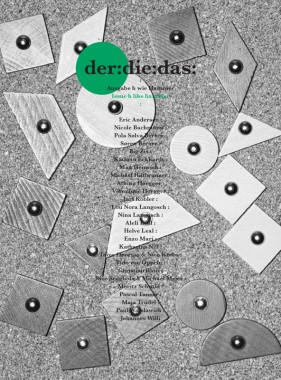
der:die:das:, Issue h like hammer
Softcover, 92 pp., offset 4/4, 200 x 270 mm
English and German
Edition of 1000
ISSN 1663-2508
Published by der:die:das:
$20.00 ·
Some words on, and images of, hammer. A magazine about common things. Featuring: Lou Nora Langosch, Johannes Willi, Katharina Nill, Pascal Tanner, Rico Scagliola, Michael Meier, Kathrin Eckhardt, Veronique Hoegger, Aleli Leal, Enzo Mari, Nichole Bachmann, Nina Langosch, Moritz Schmid, Maja Trudel, Christian Ratti, Eric Anderson, Søren Berner, Taiyo Onorato, Nico Krebs, Michael Hiltbrunner, Helvetia Leal, Max Heinrich, Paul Watzlawick, et al.
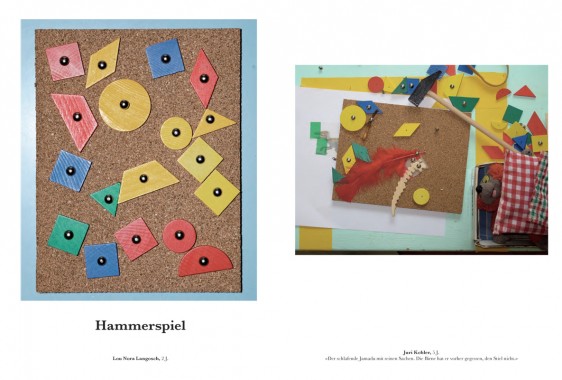

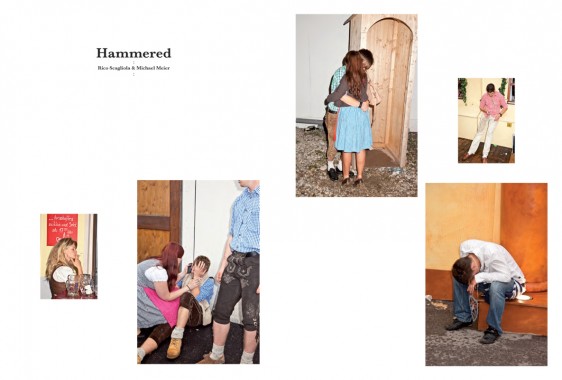
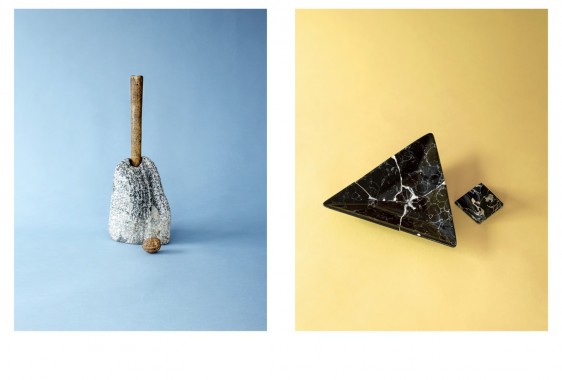
Aleli Leal, Art, Basil Rogger, Bill Gilonis, Christian Ratti, Culture, der:die:das:, Distribution, Enzo Mari, Eric Anderson, Helvetia Leal, Hin Van Tran, Johannes Willi, Katharina Nill, Kathrin Eckhardt, Lou Nora Langosch, Maja Trudel, Max Heinrich, Michael Hiltbrunner, Michael Meier, Moritz Schmid, Nadja Aebi, Nichole Bachmann, Nico Krebs, Nina Langosch, Pascal Tanner, Paul Watzlawick, Photography, Rico Scagliola, Sculpture, Søren Berner, Taiyo Onorato, Veronique Hoegger
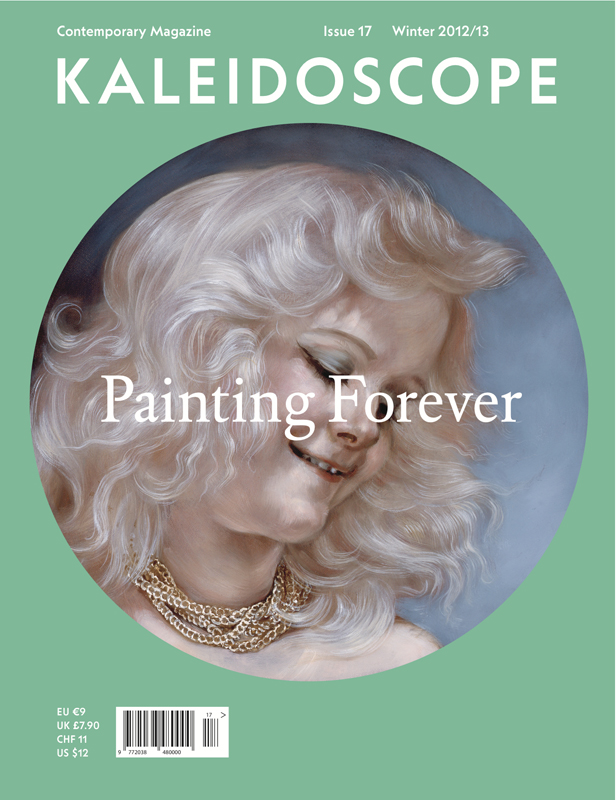
KALEIDOSCOPE Magazine 17, Painting Forever
Winter 2012/2013 — Painting Special Edition
Softcover, 224 pp. + three commissioned inserts, offset 4/4, 220 x 287 mm
ISSN 2038-4807
Published by KALEIDOSCOPE Press
$12.00 ·
“Painting Forever” is a special edition of KALEIDOSCOPE entirely dedicated to the past, present and future of the medium. The most persistent of art forms — one that was once given up for dead, then revived and is now more alive than ever — painting has been at the core of an intense research process that we undertook in collaboration with writers, curators and artists of different origins, beliefs and generations, all of whom share a desire to examine its history and envision its forthcoming possibilities. The questions we asked, and asked ourselves, were: Which artists are practicing painting in a relevant way today? Which conceptual and formal strategies, which modes of presentation and diffusion, do they deploy? And, ultimately, why? What are contemporary painters’ motives, references and perspectives? This issue is the tentative answer, and one which will hopefully foster further debate.
HIGHLIGHTS
In the opening section we introduce you to the work of five emerging artists: Oscar Murillo, Ryan Sullivan, Allison Katz, Jonathan Binet and Tala Madani. All born in the 1980s in different parts of the world, they’ve chosen to explore, revisit, celebrate and challenge the idea and practice of painting, with a common spirit of engagement and varying degrees of irony and irreverence.
MAIN THEME
This section, on the other hand, consists of extensive conversations with four artists born between the late 1950s and the early 1960s — Heimo Zoberning, John Currin, Amy Sillman and Michael Krebber — who represent divergent yet equally prominent and visionary approaches to the medium. Their common ground most revealingly lies in the influence they exert on a younger generation of artists. Accordingly, it’s no surprise that three of them hold teaching positions at eminent art schools, including the Academy of Fine Arts in Wien, Columbia University in New York and the Städelschule in Frankfurt.
MONO
This issue is likewise devoted to a painter, Los Angeles-based artist Dianna Molzan, whose practice occupies the liminal space between two-and three-dimensionality, between “pictures” and “objects,” and whose works convey a sophisticated research on abstraction encompassing elements drawn from the history of painting, as well as from design, fashion and visual culture at large.
REGULARS
This section features the work of NY–based artist Nikolas Gambaroff and of Italian conceptualist Giorgio Griffa, alongside discussions with the director of a prestigious foundation dedicated to the legacy of Pablo Picasso and the curators of an ambitious group exhibition, “Painter Painter,” soon to open at the Walker Art Center in Minneapolis.
INSERTS
Finally, this issue is enriched with commissioned inserts by three exciting young artists — Marieta Chirulescu, Fredrik Værslev and Keegan McHargue — that have each contributed a unique and affecting visual take on the making and experiencing of painting today.
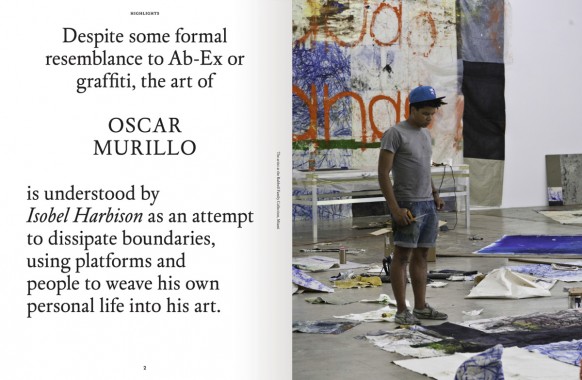
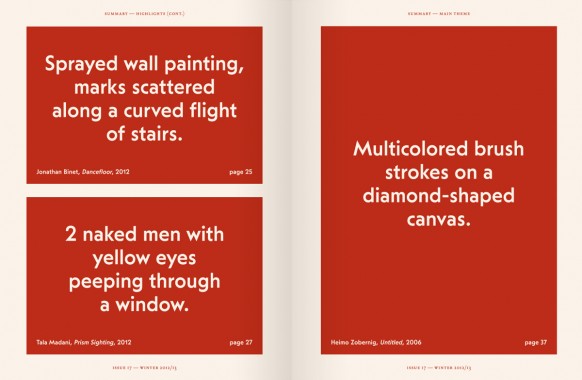

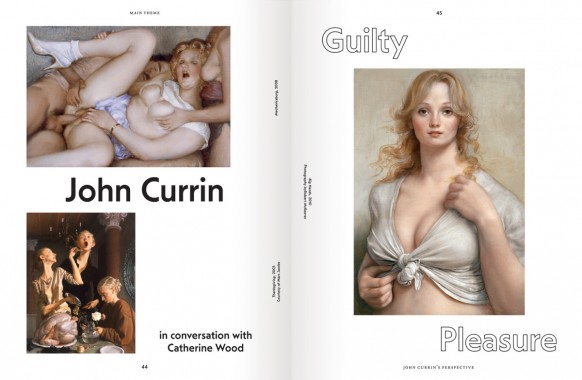

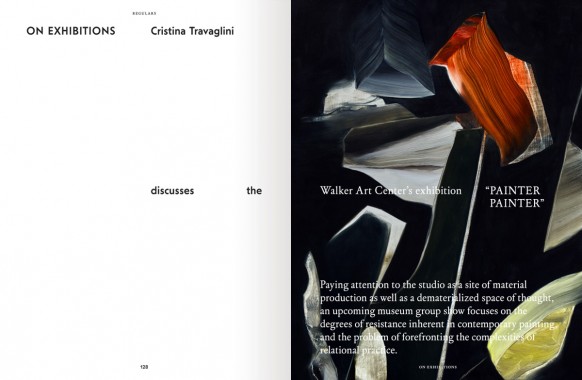
Allison Katz, Amy Sillman, Art, Cristina Travaglini, Culture, Dianna Molzan, Distribution, Fredrik Værslev, Giorgio Griffa, Heimo Zoberning, John Currin, Jonathan Binet, KALEIDOSCOPE Press, Keegan McHargue, Marieta Chirulescu, Michael Krebber, Nikolas Gambaroff, Oscar Murillo, Pablo Picasso, Painting, Ryan Sullivan, Tala Madani, Walker Art Center


fillip 17
Softcover, 156 pp., offset 4/1, 170 x 245 mm
Edition of 2500
ISSN 1715-3212
ISBN 978-1-927354-07-0
Published by Fillip
$15.00 ·
Fillip is a publication of art, culture, and ideas released three times a year.
Taking as its point of departure Giorgio Agamben’s suggestion that subjectivity emerges from the relentless struggle between living beings and the various apparatuses in which they are captured, Apparatus, Capture, Trace, reflects on the links between such apparatuses whose operations today appear increasingly intertwined: photography and biopolitics.
1. Series: Apparatus, Capture, Trace
2. David Geers, Open Call
3. Walid Sadek and Mayssa Fattouh, Tranquility is Made in Pictures
4. David Hartt, Stray Light (Portfolio)
5. Renato Rodrigues da Silva, El Instrumento y Su Obra
6. James Langdo, A Eulogy for the Cutaway
7. Miwon Kwon and Helen Molesworth, Documents Magazine, 1992-2004
8. Caren Kaplan, Aerial Photography as Biopower in the Visual Culture of 9/11
9. Maria Muhle, Imitation of Life: Biopolitics and the Cinematographic Image
Art, Caren Kaplan, David Geers, David Hartt, Design, Distribution, Fillip, Giorgio Agamben, Helen Molesworth, James Langdo, James Langdon, Jeff Khonsary, Kate Steinmann, Kristina Lee Podesva, Maria Muhle, Mayssa Fattouh, Miwon Kwon, Renato Rodrigues da Silva, Walid Sadek
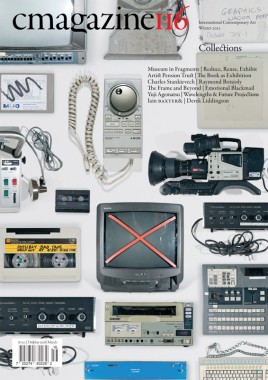

C Magazine 116, Collections
Softcover, 64 pp., offset 4/1, 210 x 295 mm
Edition of 2200
ISSN 1480-5472
Published by C Magazine
$7.50 ·
Issue 116, Collections, features essays by Steve Lyons on Ivan Moudov’s Museum in Fragments; Laura Kenins looking at Electronic Waste as Collection through the work of Laura Kikauka and Gordon Monahan, Eleanor King and Artifact Institute; Randy Gladman on the Art Collection of Alison and Alan Schwartz; Shannon d’Avout on Walid Raad and Artist Pension Trust; Anna-Sophie Springer on The Book as Exhibition, as well as an artist project by Charles Stankievech with an accompanying essay by Pandora Syperek. C Magazine 116 also includes reviews of exhibitions by Yuji Agematsu, Morgan Fisher, Raymond Boisjoly, Ian Baxter and Derek Liddington, as well as group exhibitions Emotional Blackmail at Kitchener-Waterloo Art Gallery, Wavelengths & Future Projections at the Toronto International Film Festival, Where is the Time at Foundation Izolyatsia in Ukraine, Sounding Selves at Dalhousie University Art Gallery, and Only Birds Sing the Music of Heaven in this World at the Museum of Craft and Folk Art.
Alan Schwartz, Alison Schwartz, Anna-Sophie Springer, Art, Artifact Institute, Artist Pension Trust, C Magazine, Charles Stankievech, Collections, Culture, Dalhousie University Art Gallery, Derek Liddington, Distribution, Eleanor King, Foundation Izolyatsia, Gordon Monahan, Ian Baxter, Ivan Moudov, Kitchener-Waterloo Art Gallery, Laura Kenins, Laura Kikauka, Morgan Fisher, Museum of Craft and Folk Art, Pandora Syperek, Randy Gladman, Raymond Boisjoly, Shannon d'Avout, Steve Lyons, Toronto International Film Festival, Walid Raad, Yuji Agematsu
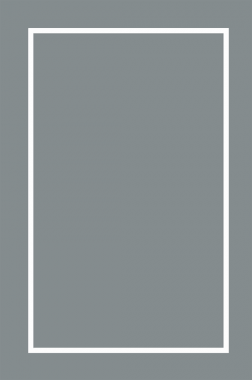
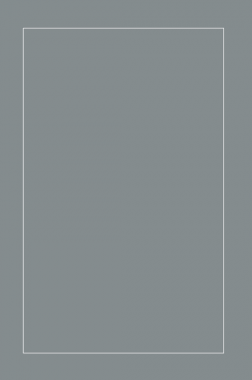
Tyler Coburn, I’m that angel
Softcover, 96 pp., offset 1/1, 6 x 9 inches
Book and performance
Edition of 500
Published by Tyler Coburn
$30.00 ·
I’m that angel is a cycle of writings and performances that explores the contemporary conditions of how we work on and against the computer, narrated from the cognitive cell of one highly neurotic user. The project considers the master narratives of technological and socioeconomic progress that have naturalized Web 2.0’s largely unprecedented user platform, as well as the pre-histories of the Millennial, the blogger and the prosumer: trenchant constituents of the digital public that figure into ongoing Western concerns with the relationships between sincerity and authenticity; realism and reality; the diaristic and the literary; and the author and the individual who nominates to take on, and produce under, that title.
Nodding to the defamiliarization strategies of Russsian formalists like Viktor Shklovskii, I’m that angel takes shape as a stony stone, a cut in the stream – a book. The format concretizes found quotes and other elements; and in every line, a pathology characteristic of our era. Call it inattentionality as method.
Designed by Eric Nylund, this book shores up the bibliographic and citational structures that underpin much of the Internet, as well as literary forms like the confessional and the epistolary that offer precedents for net vernacular. I’m that angel works to build an expanded form of the printed page that draws upon the computer screen’s predecessors: the exegetical framings of The Talmud, for example, and the columnar stutter of Derrida’s Glas. The work attempts, in short, to thread hypertext into a paraliterary matrix.
The second part of this project involves readings of the entire book, performed by actor Justin Sayre, at colocation centers worldwide. If the book sustains a material limit that belies the diffuse shape of the cloud, then these sited readings attempt to effect similar concretions by having author, actor and audience occupy a highly securitized, geopolitical and visual field that is rarely made available to the public. The first such performance occurred, over three nights in April 2012, in an all-glass, octagonal conference room, overlooking racks of servers, at Digital Realty in downtown Los Angeles.
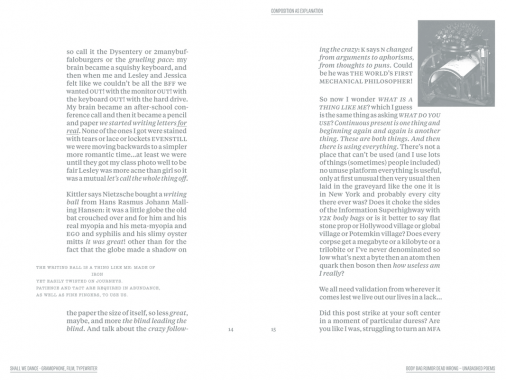


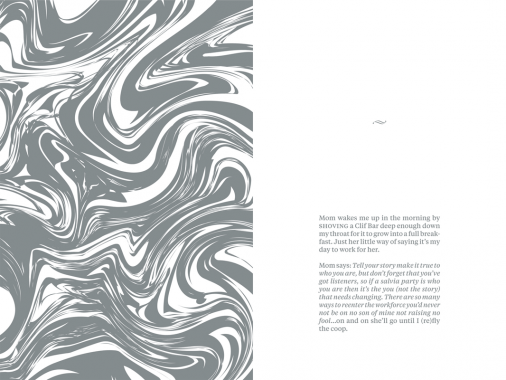

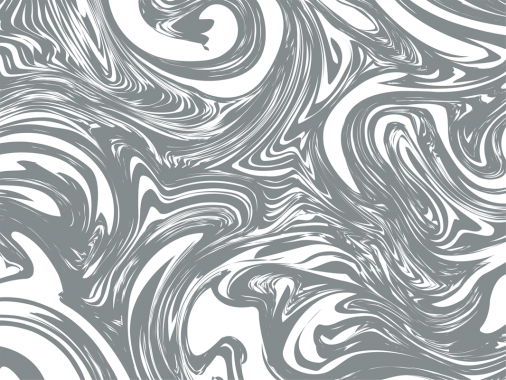
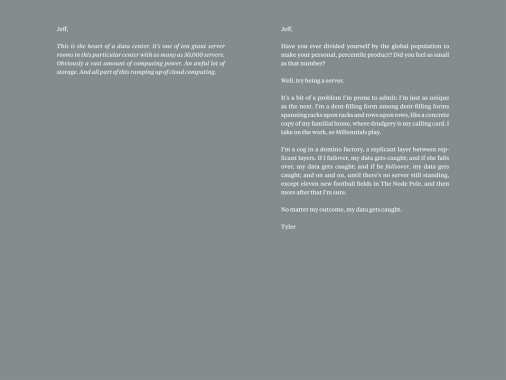
Art, Distribution, Eric Nylund, Joseph Portillo, Justin Sayre, Marc Rosenthal, Matthew Corwin, Performance, Roski School of Fine Arts, Tyler Coburn, Viktor Shklovskii
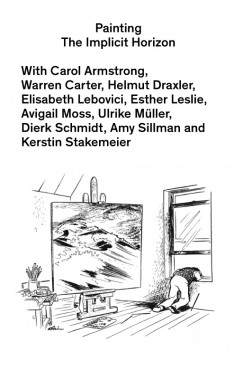

Avigail Moss and Kerstin Stakemeier, Painting — The Implicit Horizon
Softcover, 192 pp., offset 1/1, 110 x 140 mm
Edition of 500
ISBN 978-90-72076-61-8
Published by Jan van Eyck Academie
$11.00 · out of stock
Painting — The Implicit Horizon documents a symposium which took place at the Jan van Eyck Academie in Maastricht, the Netherlands. The book presents essays and transcripts of discussions between European and American artists, art historians, and critics who have looked at some of the ways painting has been conceived of in the eras after Conceptual Art. Addressing ideas of production and consumption, critiques of the end of art, issues of age, accomplishment, and the myth of the painter, the book posits that painting, as a working practice as well as a historical referent, serves as an implicit horizon or limit condition for other media.
“Jimson lives in a ramshackle houseboat on the Thames river, where he reminisces about the days when the state collected his paintings, hides from the police (who pursue him for his minor infractions and debts) and schemes about how to extract money from various wealthy patrons. That is, his struggles are conceptual, material and financial and always involve a race against time and an acknowledgement of his own limitations even in light of his successes. After a series of roguish scrapes, he finally receives a retrospective at Tate Britain: a triumph that does little to alleviate his destitution. But the film’s dénouement comes when Jimson paints a “monument to England”: a giant mural representing “The last Judgment” on the side of a bombed-out church aided by a cadre of voluntary art student assistants who he keeps remunerated in cups of coffee. The film ends when Jimson — threatened by council developers looking to capitalize on the land — voluntarily bulldozes his mural in advance of the city bureaucrats and sails off down the Thames in search of a new horizon: perhaps another, larger wall (or a further expansion of painting as such).”
CONTRIBUTORS
Carol Armstrong, Warren Carter, Helmut Draxler, Kerstin Stakemeier, Elisabeth Lebovici, Esther Leslie, Avigail Moss, Ulrike Müller, Dierk Schmidt, and Amy Sillman.
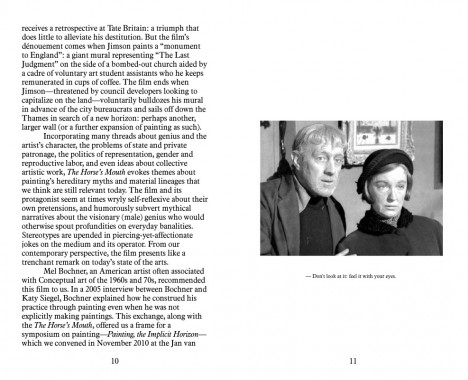
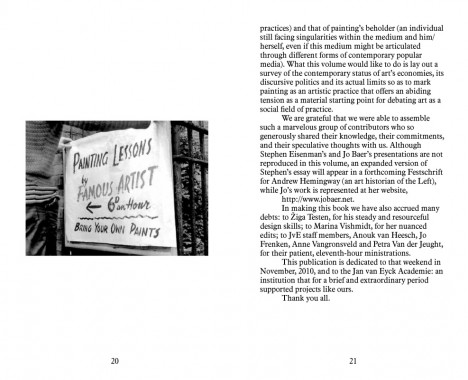
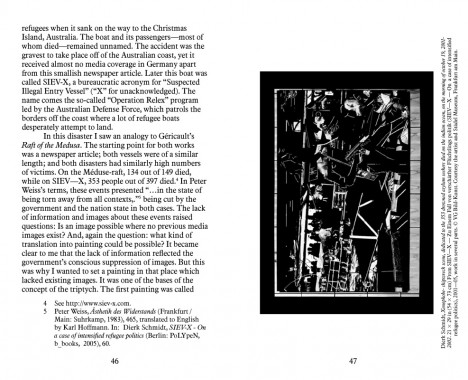
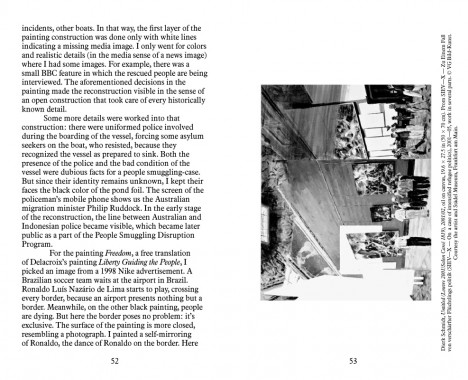
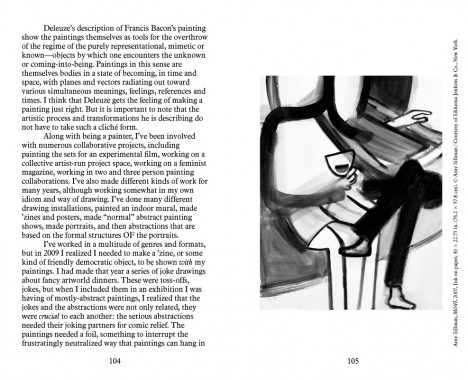


Alan Smart, Amy Sillman, Annet Perry-Schoot, Anouk van Heesch, Art, Avigail Moss, Carol Armstrong, Criticism, Culture, Daniel Brustlein, Dierk Schmidt, Distribution, Elisabeth Lebovici, Esther Leslie, Fox Hysen, Gully Jimson, Helmut Draxler, Jan van Eyck Academie, Jo Baer, John Bratby, Katja Diefenbach, Kerstin Stakemeier, Marina Vishmidt, Minika Baer, Painting, Ronald Neame, Sir Alec Guinness, Stephen Eisenman, Theory, Ulrike Müller, Warren Carter, Žiga Testen

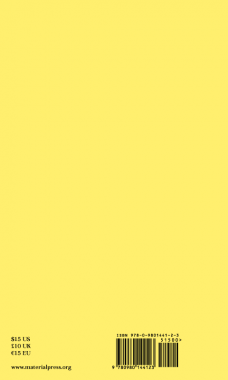
Ginny Cook and Kim Schoen, MATERIAL 3
Softcover, 96 pp. + insert, offset 2/1, 160 x 270 mm
Edition of 500
ISBN 978-0-9801441-2-3
Published by MATERIAL Press
$15.00 ·
MATERIAL exists as a platform for the artist’s voice. Each issue brings together a different group of artists who write, as well as a new collaboration with a graphic designer. During the production of this third issue, our designer Zak Jensen put forth the idea of concatenation — the act of linking together, or the state of being joined (
It was caused by an improbable concatenation of circumstances) (there was a connection between eating that pickle and having that nightmare)
(the joining of hands around the table).
Concatenation (c.1600, from L.L. concatenatus, pp. of concatenare “to link together,” from com- “together”+ catenare, from catena “a chain”) seemed an appropriate word for our editorial method. An unlikely assemblage of texts becomes connected through this process; uncanny linkages emerge. Wyeth appears twice. Performances interact. In this issue: voices that duel, voices that parrot, voices that hypothesize, translate, and meditate, voices that speak simultaneously. As Roland Barthes writes, we have assembled these textual events, as “pleasure in pieces; language in pieces; culture in pieces,” to build upon one another into something new.*
*Roland Barthes, The Pleasure of the Text, trans. Richard Miller (New York: Hill and Wang, 1975), p. 51
CONTRIBUTORS
Farrah Karapetian, Paul Zelevansky, Renee Petropoulous, Nate Harrison, James Welling, Natalie Häusler, Harold Abramowitz, Shana Lutker Stephanie Taylor, Alice Könitz, Frank Chang, and Emily Mast.

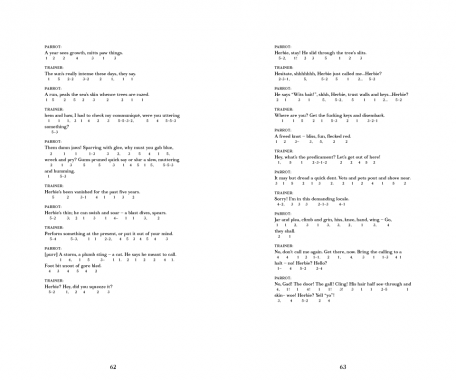



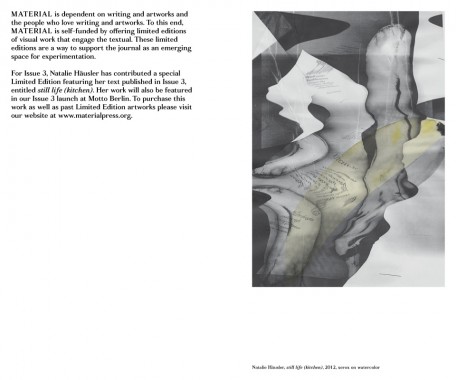
Alice Konitz, Andrew Wyeth, Art, Catherine Guiral, Concatenare, Criticism, Daniel Lucas, Design, Distribution, Dorit Cypis, Emily Mast, Farrah Karapetian, Frank Chang, Ginny Cook, Harold Abramowitz, James Welling, John Stezaker, Jonathan Miles, Kim Schoen, MATERIAL Press, Natalie Häusler, Nate Harrison, Olivier Richon, Paul Zelevansky, Quentin Walesch, Renee Petropoulous, Richard Miller, Roland Barthes, Shana Lutker, Stephanie Taylor, Theory, Thomas Lawson, Typecraft Wood & Jones, Typography, Wendy Schoen, Zak Jensen
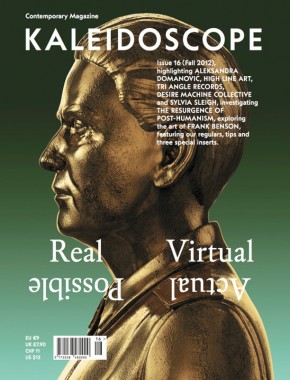
KALEIDOSCOPE Magazine 16 — Fall 2012
Softcover, 210 pp. + Ken Price Drawings insert, offset 4/4, 220 x 287 mm
ISSN 2038-4807
Published by KALEIDOSCOPE Press
$12.00 ·
At the core of a platform that includes an exhibition space and an independent publishing house, KALEIDOSCOPE is an international quarterly of contemporary art and culture founded in 2009 in Milan. Distributed worldwide on a seasonal basis, it has gained widespread recognition as a trusted and timely guide to the present (but also to the past and possible futures), unique in its interdisciplinary and unconventional approach.
HIGHLIGHTS
This issue’s opening section features Aleksandra Domanovic, whose videos and sculptures are seen by Pablo Larios as embodiments of the perpetually productive disunion of politics and art; the ambitious public art program of New York’s High Line, described by Piper Marshall as one that confronts artists with many challenges; the record label Tri Angle, whose founder Robin Carolan talks to Ruth Saxelby about how to embody the zeitgeist of electronic music; the Indian duo Desire Machine Collective, who discuss with Sandhini Poddar and Ulrich Baer about mapping an experimental history of colonization; and American painter Sylvia Sleigh, whose elusive politics is contrasted by Joanna Fiduccia to the detailed realism of her portraits.
MAIN THEME
The blend of cybernetics and underground culture realized in the symbolic and mythological repertoire of Cyberpunk continues to inspire sci-fi narratives and permeate the arts, reinforcing its status as a powerful aesthetic. This issue examines the emergence of an art that addresses the processes of mechanization, desexualisation and reification of the human body, and how they relate to questions of identity, morality and fantasy. Featured contributions include Michele D’Aurizio’s overview of the work of a new generation of artists; Karen Archey’s analysis of the work of Canadian artist David Altmejd; a discussion between Brody Condon and Jason Brown coordinated by DIS magazine; and a conversation between young artist Timur Si-Qin and influential philosopher Manuel De Landa.
MONO
Comprising an essay by Alessandro Rabottini, an interview by Matt Keegan and a photographic portrait by Grant Willing, this issue’s MONO is devoted to American artist Frank Benson, whose work rides the dialectic between the space of the photographic image and the space of sculpture. Evoking celebrated artists like Charles Ray, Jeff Koons and Robert Gober, Benson uses the latest technology available and yet imbues the sculptural process with a profound understanding of physical materiality — making works that oscillate between analogue and digital, solidity and suspension, humor and elegance.
REGULARS
Hans Ulrich Obrist interviews the New York-based provocateur Liz Magic Laser; Dorothée Dupuis introduces the hidden life of Marseille; Luca Cerizza analyzes the emotional topography of Alberto Garutti; and Carson Chan meets the DAAD’s visual arts director Ariane Beyn. The edition is enriched by our seasonal tips on following, reading, listening, stopping by, meeting and visiting; as well as by three special inserts — drawings by Ken Price, stickers by Alistair Frost and images by Alistair Frost.
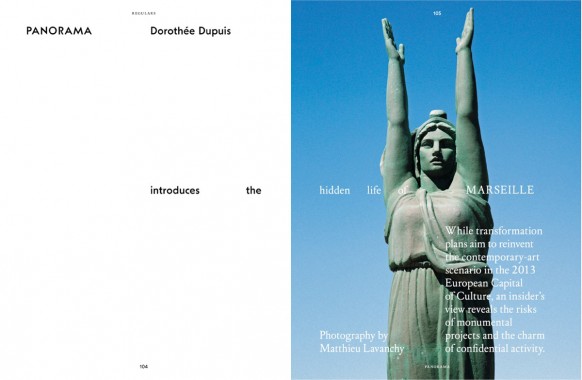
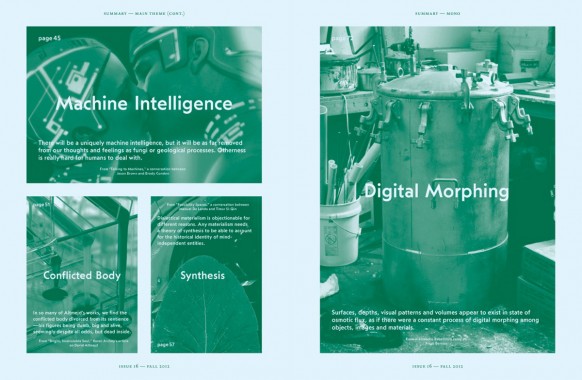



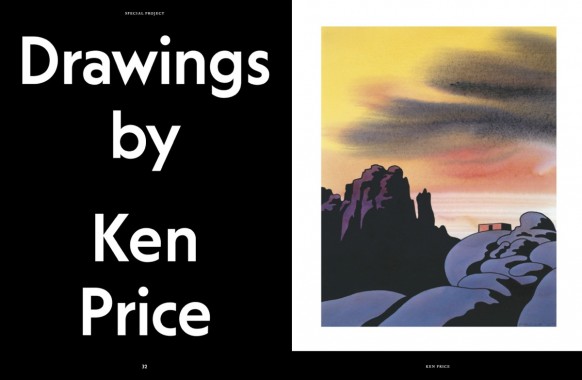
Alberto Garutti, Aleksandra Domanovic, Alessandro Rabottini, Alistair Frost, Ariane Beyn, Art, Brody Condon, Carson Chan, Charles Ray, Cyberpunk, David Altmejd, Desire Machine Collective, DIS Magazine, Distribution, Dorothée Dupuis, Drawing, Frank Benson, Grant Willing, Hans Ulrich Obrist, Jason Brown, Jeff Koons, Joanna Fiduccia, KALEIDOSCOPE Press, Karen Archey, Ken Price, Liz Magic Laser, Luca Cerizza, Manuel De Landa, Matt Keegan, Michele D'Aurizio, Pablo Larios, Piper Marshall, Robert Gober, Robin Carolan, Ruth Saxelby, Sandhini Poddar, Sculpture, Sylvia Sleigh, Timur Si-Qin, Tri Angle, Ulrich Baer
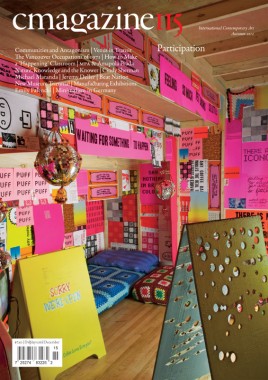

C Magazine 115, Participation
Softcover, 64 pp., offset 4/1, 210 x 295 mm
Edition of 2200
ISSN 1480-5472
Published by C Magazine
$7.50 ·
Issue 115, Participation, features essays by Vesna Krstich on how to make a ‘Happening’ classroom, Leah Modigliani on the Vancouver Occupations of 1971, Amy Fung on communities and antagonism, Rachel Anne Farquharson on recollecting through the works of Kerry Tribe, Petrina Ng and Lindsay Seers, as well as Corrine Fitzpatrick in response to our recent “Men” issue. C Magazine 115 also includes an artist project by MPA and Amapola Prada, book reviews and reviews of exhibitions by Jeremy Deller, Janieta Eyre, Emily Falencki, Sean MacAlister, Michael Maranda, Rory Middleton and Cindy Sherman, among others.
Amapola Prada, Amy Fung, Art, C Magazine, Cindy Sherman, Corrine Fitzpatrick, Culture, Distribution, Emily Falencki, Janieta Eyre, Jeremy Deller, Kerry Tribe, Leah Modigliani, Lindsay Seers, Michael Maranda, MPA, Petrina Ng, Rachel Anne Farquharson, Rory Middleton, Sean MacAlister, Vesna Krstich

Enrique Santos, The Mexican Suitcase
Softcover with flaps, 360 pp., offset 4/1, 200 x 240 x 32 mm
English and Spanish
Edition of 2000
ISBN 978-607-7636-29-8
Published by Landucci
$45.00 ·
The Mexican Suitcase is the result of more than three years of work by the Mexican-based Argentinian artist, Enrique Santos. This artist book could be, amongst other things, a ‘catalogue’ of an apocryphal exhibition that is not meant to be, one that from its very beginning proposes a reverse path to that already established — first the book, and then? Ever since this basic wink (not to mention that the title itself is an appropriation) Enrique Santo’s work addresses the idea of “robbery”. Using diverse languages and tools (photography, collage, video, sculpture, film, installations) the artist reflects upon the contemporary artistic works in a sociocultural and political environment of violence in which we find ourselves immersed. Robbery as a metaphor of appropriation and “postproduction” — in Bourriaud’s definition of the word — as an element specific of an artistic way of producing, that is loaded with intertextuality, reference, discourse and images that roam our daily lives.
Santos’ work is a way of thinking about how contemporary art is produced, and at the same time it talks about the gaze, the interpretation of he/she who observes, the understanding and production that comes with every look. It reflects upon a single active spectator, who builds a discourse, appropriates all meanings and elaborates on them according to his life story, and his social, cultural and emotional capital. That gaze has a filter through which history is interpreted. It talks about and with the viewer without underestimating his capacity for understanding. From the very beginning, the book presents a relationship of shared complicity, discourse, codes and understandings, but demands a lucid and imaginative perspective.
Retaking film, journalistic, documentary and advertising language, Santos quotes and reinterprets the great thieves of the screen and some real criminals, in order to talk about lies, confusions, myths and misunderstandings, as well as an ever more violent and heartbreaking reality that crawls into our lives through trivialized and shallow images.
— Florencia Magaril
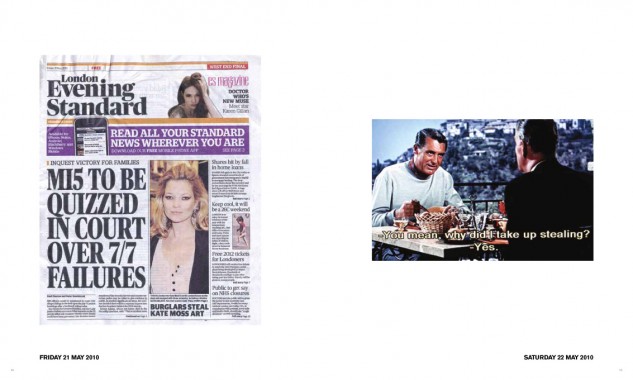

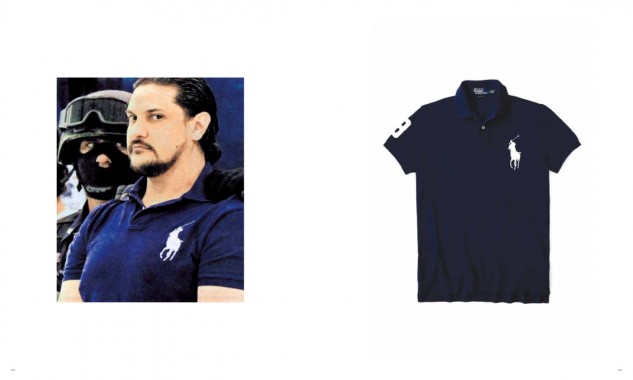
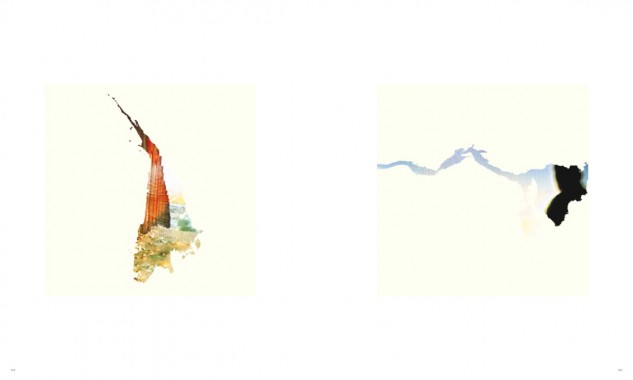



Aaron Smuts, Antonieta Cruz, Art, Deleuze & Guattari, Distribution, Edward Said, Enrique Santos, Film, Florencia Magaril, Gilberto Salinas, Goya, Graham Huggan, Guadalajara, Jalisco, Jean-Luc Goddard, Jorge Luis Borges, Landucci, Marshal McLuhan, Mexico, Pepe Montelongo, Photography, Randy Kennedy, Roland Barthes, Roman Gubern, Sculpture, Tera Patrick, Werner Herzog

Outpost Journal 2, Baltimore
Softcover, 64 pp. + insert, offset 4/4, 9 x 12 inches
Edition of 500
ISBN 978-0-9836082-1-9
Published by Outpost Journal
$15.00 ·
Outpost is an annual print publication on art, design and community action from cities that have been traditionally underexposed beyond their local contexts. Each beautifully produced and visually engaging issue of Outpost focuses on a single urban location and comes packaged with a limited edition print by an artist from the featured city. Outpost is a journey into the creative heart of a place, and via features like “Secretly Famous” (profiles of the most infamous artsy locals), guerrilla engagements with tourist attractions, historical explorations, mapping projects, and deep dives into artist collectives and organizations, Outpost exposes the myriad ways in which unique local communities arise through creative collaboration and production.
Exploratory and playful, critical with a sense of levity, and inspired by hand-drawn maps, flags, totem poles, poorly pixelated iPhone photos, moody landscapes, and the spirit of adventure, Outpost is dedicated to strengthening ties between communities and spreading new ideas about how creative culture can change our world.

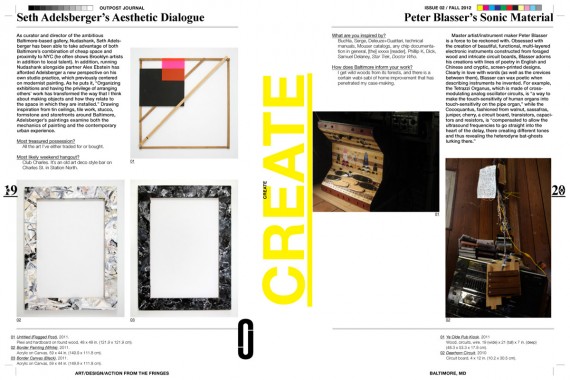

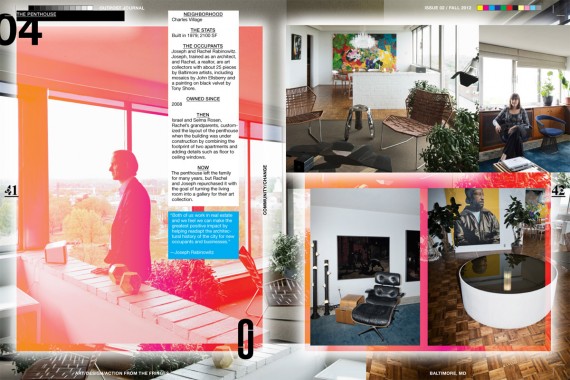

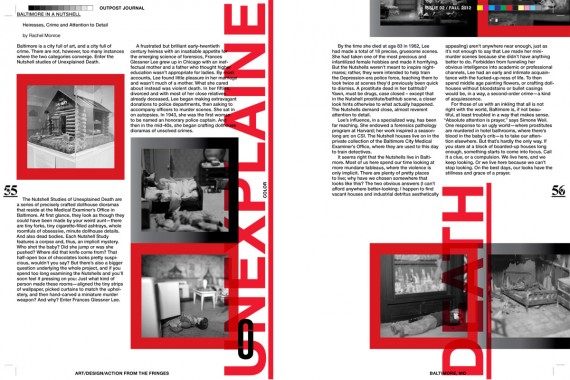
Aja Blanc, Alex Kwartler, Anusha Venkataraman, Architecture, Art, Boddan Mohora, Bogdan Mohora, Caitlin Cunningham, Carly Ptak, Clay Rockefeller, Culture, Dan Deacon, Design, Distribution, Elizabeth Evitts Dickinson, Gary Kachadourian, Gillian Kiley, James Rieck, Jay Peter Salvas, Jeanne Vaccaro, John Bohl, Jori Ketten, Kyla Fullenwider, Laure Drogoul, Lesser Gonzalez Alvarez, Loring Cornish, Luke T. Baker, Maggie Lange, Manya Rubinstein, Matthew Williams, Mike Taylor, Outpost Journal, Patrick Casey O'Brien, Pete Oyler, Peter Blasser, Phoebe Jean, Phoebe Jean Dunne, Rachel Monroe, Seth Adelsberger, Shaun Flynn, Twig Harper
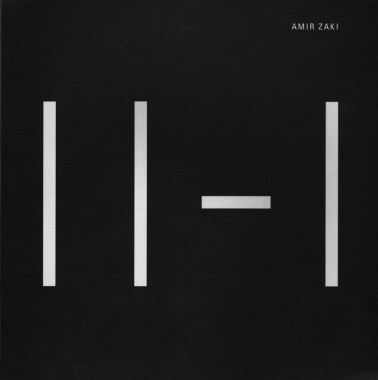
Amir Zaki, Eleven Minus One
Softcover, 122 pp., offset 4/4, 9 x 9 inches [26 x 36 inches unfolded]
Edition of 500
ISBN 978-0-26172-2-9
Published by LAXART
$75.00 ·
For this project,
Amir Zaki carefully reconstructed and reinterpreted, in virtual 3D space, several photographs from a series made in the mid-1980’s by Swiss artist duo Peter Fischli and David Weiss. Their photographs depict precariously balancing temporary sculptures that they intentionally constructed in a slap-dash manner. Their photographs of these sculptures were casually shot in their studio using unprofessional lighting and equipment. Through these photographs of temporary sculptural constructs made of household detritus, Fischli and Weiss subvert the idea of sculpture as a heroic manifestation of a unique and masterfully constructed object. Their work privileges the document over the sculpture, which Zaki interprets as an ironic inverse of the ubiquitous professional photographic documentation of the ‘serious’ sculpture found in so many art books and journals. In Zaki’s adaptation of their work, there is a re-inversion at play as he privileges the sculpture again, but only as a 3D virtual non-object in order to destabilize their relationship. This has manifested as a series of short photorealistic animation loops and a foldout book based on the eleven different ways that a cube can be unfolded. Working with this methodology allowed Zaki to further interrogate the conventions and limitations of photography by exploring depictions of ‘real’ space, but without the restraints of actual physics or forces such as gravity. Zaki is interested in the perversion of using Fischli and Weiss photographs of quickly made, throw-away sculptures as a source to create an incredibly laborious photorealistic virtual 3D scene that can be explored from all angles, both through photographic and orthographic projections. In this project Zaki has also fetishized the sculptures by making them virtual, stylized and idealized. He has resurrected these sculptures and placed them in a world where they need not ever ‘fall’ (fail). In the animations Zaki has created, the sculptures simply spin, teeter or gyrate indefinitely. In the photographs Zaki has rendered for the book, the sculptures hover in a perfect orthographic projection space, surrounded by a black void.
The book is a complex foldout design that is quite difficult to describe in text. It is ten double-sided square pages. Each page spread unfolds into unique configurations of six squares that represent all sides of a cube. The images on each unfolded page spread depict 3D digital recreations of photographs from the series Equilibres by Swiss artist duo Peter Fischli and David Weiss. When fully unfolded, the book opens up to approximately 27 x 36 inches. It is an interactive object, and can be folded and unfolded in multiple ways, creating grids, cubes, and unfolded boxes, each creating a unique experience and juxtaposition of images. It is important to recognize the book in terms of a limited edition or a multiple. It is also more of an object with sculptural qualities and a tactile nature than a ‘book’ in the traditional sense.
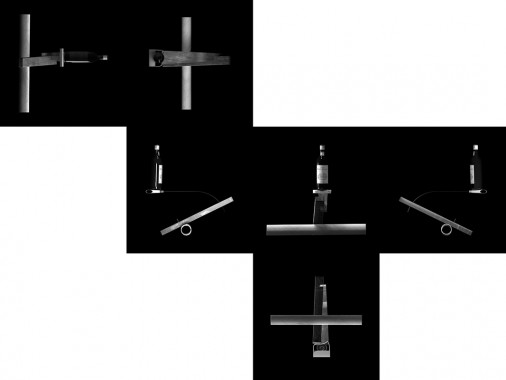


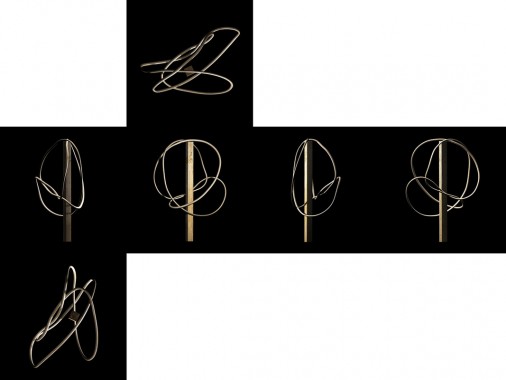
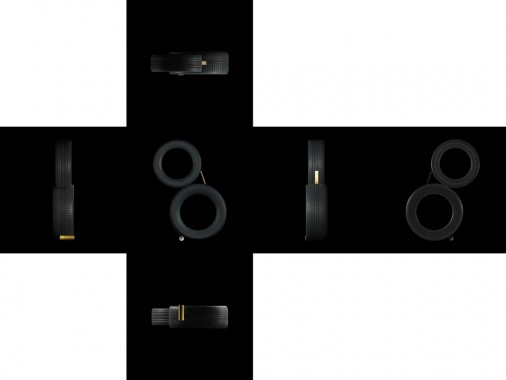
Amir Zaki, Art, David Weiss, Distribution, Eighth Veil, Greenblatt-Wexler, LAXART, Peter Fischli, Photography, Sculpture

der:die:das:, Issue g like glühbirne (light bulb)
Softcover, 92 pp., offset 4/1, 200 x 270 mm
English and German
Edition of 1000
ISSN 1663-2508
Published by der:die:das:
$20.00 ·
Some words on, and images of, glühbrine (light bulb). Featuring: Joseph Beuys, Big Zis, Lorenz Cugini, Vilem Flusser, Robert Gober, Colin Guillemet, Christina Hemauer, Roman Keller, Veronique Hoegger, et al.





Aleli Leal, Anne Schwalbe, Art, Big Zis, Christina Hemauer, Colin Guillemet, Culture, der:die:das:, Distribution, Flurina Rothenberger, Isabelle Krieg, Jeff Wall, Jens Lubbadeh, Joseph Beuys, Judith Wyder, Katharina Hohmann, Katharina Rippstein, Lorenz Cugini, Lukas Zimmermann, Photography, Robert Gober, Roman Keller, Sculpture, Sherrie Levine, Stefan Mauck, Tobias Madison, Veronique Hoegger, Vilem Flusser













































































